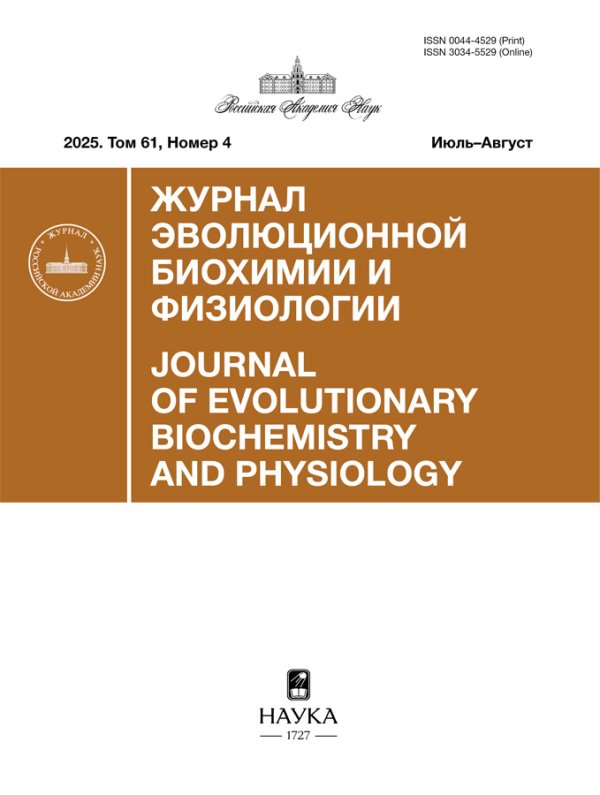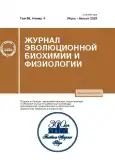Кальций-аккумулирующая способность митохондрий печени крыс при гипотермии различной длительности
- Авторы: Хизриева С.И.1, Халилов Р.А.1, Джафарова А.М.1, Абдуллаев В.Р.1
-
Учреждения:
- Дагестанский государственный университет
- Выпуск: Том 59, № 4 (2023)
- Страницы: 311-319
- Раздел: ЭКСПЕРИМЕНТАЛЬНЫЕ СТАТЬИ
- URL: https://journals.rcsi.science/0044-4529/article/view/136711
- DOI: https://doi.org/10.31857/S0044452923040046
- EDN: https://elibrary.ru/YXUJTY
- ID: 136711
Цитировать
Полный текст
Аннотация
Кальций является одним из важнейших внутриклеточных мессенджеров, регулирующих физиологические и биохимические процессы в клетке. Митохондрии способны депонировать ионы кальция и участвуют в регуляции кальциевого сигнала. Гипотермические состояния у гомойотермных животных могут привести к нарушению этой важнейшей функции митохондрий и патологическим последствиям. Целью данного исследования является изучение эффектов умеренной (30°С) гипотермии различной длительности на кальций-аккумулирующую способность митохондрий печени крыс. Опыты проводились на крысах-самцах Вистар. Гипотермию вызывали наружным охлаждением животных в плексигласовых камерах с рубашкой, через которую циркулировала холодная вода. Выделение митохондрий из печени декапитированных крыс производили методом дифференциального центрифугирования. Кальций-аккумулирующую способность митохондрий оценивали по кинетике кальций-индуцированного набухания митохондрий и их кальциевой емкости. Исследование кинетики кальций-индуцированного набухания митохондрий показало, что при кратковременной умеренной (30°С) гипотермии скорость набухания митохондрий снижается, пролонгирование гипотермии до 1 ч способствует дальнейшему снижению скорости набухания, а до 3 ч – ее нормализации. Между скоростью кальций-индуцированного набухания и кальциевой емкостью митохондрий выявлена положительная корреляционная связь (r = 0.79). Таким образом, при длительном воздействии холодового фактора у крыс происходит активация ряда компенсаторно-приспособительных реакций. Снижение скорости Са2+ – индуцированного набухания и кальциевой емкости митохондрий на начальных этапах гипотермии, возможно, связано с образованием митохондриальных пор и носит обратимый характер.
Ключевые слова
Об авторах
С. И. Хизриева
Дагестанский государственный университет
Email: albina19764@mail.ru
Россия, Республика Дагестан, г. Махачкала
Р. А. Халилов
Дагестанский государственный университет
Email: albina19764@mail.ru
Россия, Республика Дагестан, г. Махачкала
А. М. Джафарова
Дагестанский государственный университет
Email: albina19764@mail.ru
Россия, Республика Дагестан, г. Махачкала
В. Р. Абдуллаев
Дагестанский государственный университет
Email: albina19764@mail.ru
Россия, Республика Дагестан, г. Махачкала
Список литературы
- Vasington FD, and Murphy JV (1962) Ca ion uptake by rat kidney mitochondria and its dependence on respiration and phosphorylation. J Biol Chem 237:2670–2677. https://doi.org/10.1016/s0021-9258(19)73805-8
- Denton RM (2009) Regulation of mitochondrial dehydrogenases by calcium ions. Biochim Biophys Acta Bioenergy 1787(11):1309–1316. https://doi.org/10.1016/j.bbabio.2009.01.005
- Polderman KH (2009) Mechanisms of action, physiological effects, and compli-cations of hypothermia. Critical Care Med 37 (7):186–202. https://doi.org/10.1097/CCM.0b013e3181aa5241
- Sun YJ, Zhang ZY, Fan B, Li G-Y (2019) Neuroprotection by Therapeutic Hypothermia. Front Neurosci13. https://doi.org/10.3389/fnins.2019.00586
- Paal P, Brugger H, Strapazzon G (2018) Accidental hypothermia. Handbook of Clinical Neurology. 157:547–563. https://doi.org/10.1016/b978-0-444-64074-1.00
- Paal P, Pasquier M, Darocha T, Lechner R, Kosinski S, Wallner B, Zafren K, Brugger H (2022) Accidental Hypothermia: 2021 Update. Int J Environ Res Public Heal 19:501. https://doi.org/10.3390/ijerph19010501
- Søreide K (2014) Clinical and translational aspects of hypothermia in major trauma patients: from pathophysiology to prevention, prognosis and potential preservation. Injury 45(4):647–654. https://doi.org/10.1016/j.injury.2012.12.027
- Hakim SM, Ammar MA, Reyad MS (2018) Effect of therapeutic hypothermia on survival and neurological outcome in adults suffering cardiac arrest: a systematic review and meta-analysis. Minerva Anestesiol 84(6):720–730. https://doi.org/10.23736/S0375-9393.18.12164-X
- Yamada KP, Kariya T, Aikawa T, Ishikawa K (2021) Effects of Therapeutic Hypothermia on Normal and Ischemic Heart. Front Cardiovasc Med 8. https://doi.org/10.3389/fcvm.2021.642843
- Onose G, Anghelescu A, Blendea D, Ciobanu V, Daia C, Firan FC, Oprea M, Spinu A, Popescu C, Ionescu A, Busnatu S, Munteanu C (2022) Cellular and Molecular Targets for Non-Invasive, Non-Pharmacological Therapeutic/Rehabilitative Interventions in Acute Ischemic Stroke. Int J Mol Sci 23:(907). https://doi.org/10.3390/ijms23020907
- Кличханов НК, Исмалова ЖГ, Астаева МД (2016) Интенсивность свободнорадикальных процессов в крови крыс при глубокой гипотермии и в ходе самосогревания. Бюл ВСНЦ СО РАМН 1(5):104–109. [Klichkhanov NK, Ismailova ZG, Astaeva MD. Intensity of free radical processes in rats’ blood while deep hypothermia and self-warming. Acta Biomed Sci 1(5):104–109. (In Russ)]. https://doi.org/10.12737/23402
- Alva N, Palomeque J, Carbonell T (2013) Oxidative Stress and Antioxidante Activity in Hypothermia and rewarming: can RONS Modulate the Benefical Effects of Therapeutic Hypothermia. Oxidative Med Cel Longevit 2013:20–28. https://doi.org/10.1155/2013/957054
- Schaible N, Han YS, Tveita T, Siecka GC (2018) Role of Superoxide Ion Formation in Hypothermia/Rewarming Induced Contractile Dysfunction in Cardiomyocytes. Cryobiology 81:57–64. https://doi.org/10.1016/j.cryobiol.2018.02.010
- Khalilov RA, Dzhafarova AM, Khizrieva SI, Abdullaev VR (2019) The Intensity of Free Radical Processes on Rat Liver Mitochondria under Moderate Hypothermia of Various Duration. Cell Tissue Biol 13:446–456. https://doi.org/10.1134/S1990519X1906004X
- Khizrieva SI, Khalilov RA, Dzhafarova AM, Abdullaev VR (2022) Antioxidant Status of Rat Liver Mitochondria under Conditions of Moderate Hypothermia of Different Duration. Bull Exp Biol Med 172(3):305–309. https://doi.org/10.1007/s10517-022-05382-w
- Khalilov RA, Khizrieva SI, Dzhafarova AM, Abdullaev VR (2020) The Bioenergetic characteristics of mitochondria of the rat liver at low body temperatures. Probl Biol Med Pharmaceut Chem 22(5):35–41. https://doi.org/10.29296/25877313-2019-05-07
- Kowaltowski AJ, Castilho RF, Vercesi AE (2001) Mitochondrial permeability transition and oxidative stress. FEBS Letters 495(1-2):12–15. https://doi.org/10.1016/S0014-5793(01)02316-X
- Baranov SV, Stavrovskaya IG, Brown AM, Tyryshkin AM, Kristal BS (2008) Kinetic Model for Ca2+-induced Permeability Transition in Energized Liver Mitochondria Discriminates between Inhibitor Mechanisms. J Biol Chem 283(2):665–676. https://doi.org/10.1074/jbc.M703484200
- Рыбальченко ВК, Коганов ММ (1998) Структура и функции мембран. – Киев: ВШ. 312 с. [Rybalchenko VK, Koganov MM (1998) Membrane structure and functions. Kiev: VSh. 312 p. (In Russ)].
- Lowry DH (1951). Protein measurement with the Folinphenol reagent. J Biol Chem 193(1):265–275. https://doi.org/10.1016/s0021-9258(19)52451-6
- Brookes PS, Darley-Usmar VM (2004) Role of calcium and superoxide dismutase in sensitizing mitochondria to peroxynitrite-induced permeability transition. Am J Physiol Heart Circ Physiol 286:39–46. https://doi.org/10.1152/ajpheart.00742.2003
- Marinelli F, Almagor L, Hiller R, Giladi M, Kha-nanshvili D, Faraldo-Gómez J, Kaback HR (2014) Sodium recognition by the Na+/Ca2+ exchanger in the out ward facing conformation. Proc Natl Acad Sci U S A 111:5354–5362. https://doi.org/10.1073/pnas.1415751111
- Tsai MF, Jiang D, Zhao L, Clapham D, Miller CJ (2014) Functional reconstitution of the mitochondrial Ca2+/H+ antiporter Letm1. Gen Physiol 143(1): 67–73. https://doi.org/10.1085/jgp.201311096
- Belosludtsev KN, Dubinin MV, Belosludtseva NV, Mironova GD (2019) Mitochondrial Ca2+ Transport: Mechanisms, Molecular Structures, and Role in Cells. Biochemistry (Moscow) 84(6):593–607. https://doi.org/10.1134/s0006297919060026
- Petronilli V, Cola C, Massari S, Colonna R, Bernardi P (1993) Physiological effectors modify voltage sensing by the cyclo-sporin A-sensitive permeability transition pore of mitochondria. J Biol Chem 268(29):21939–21945. https://doi.org/10.1016/s0021-9258(20)80631-0
- Belosludtsev KN, Belosludtseva NV, Mironova GD (2005) Possible mechanism for formation and regulation of the palmitate-induced cyclosporin A-insensitive mitochondrial pore. Biochemistry (Moscow) 70(7):987–994. https://doi.org/70(7):815-21. https://doi.org/10.1007/s10541-005-0189-x
- Zoratti M, Szabb I (1995) The mitochondrial permeability transitions. Biochim Biophys Acta 1241(2):139–176. https://doi.org/10.1016/0304-4157(95)00003-a
- Halestrap AP (2009) What is the mitochondrial permeability transition pore? J Mol Cel Cardiol 46:821–831. https://doi.org/10.1016/j.yjmcc.2009.02.021
- Gunter TE, Yule DI, Gunter KK, Eliseev RA, Salter JD (2004) Calcium and mitochondria. FEBS Letters 567(1):96–102. https://doi.org/10.1016/j.febslet.2004.03.071
- Bernardi P, Di Lisa F (2014) The mitochondrial permeability transition pore: Molecular nature and role as a target in cardioprotection. J Mol Cel Cardiol 78:100–106. https://doi.org/10.1016/j.yjmcc.2014.09.023
- Batandier CC, Leverve X, Fontaine E (2004) Opening of the Mitochondrial Permeability Transition Pore Induces Reactive Oxygen Species Production at the Level of the Respiratory Chain Complex I. J Biol Chem 279(17):17197–17204. https://doi.org/10.1074/jbc.m310329200
- McStay GP, Clarke SJ, Halestrap AP (2002) Role of critical thiol groups on the matrix surface of the adenine nucleotide translocase in the mechanism of the mitochondrial permeability transition pore. Biochem J 367:541–548. https://doi.org/10.1042/BJ20011672













